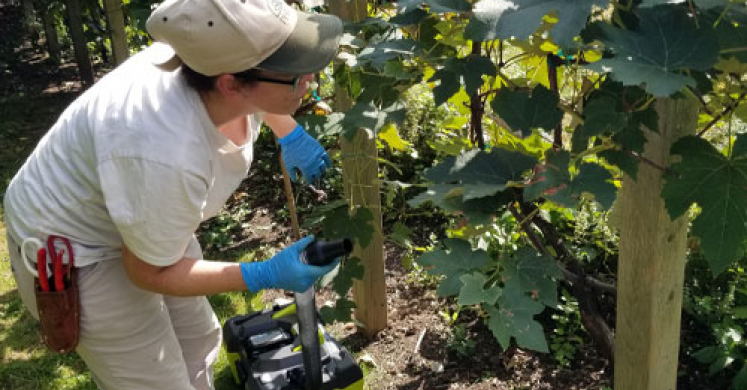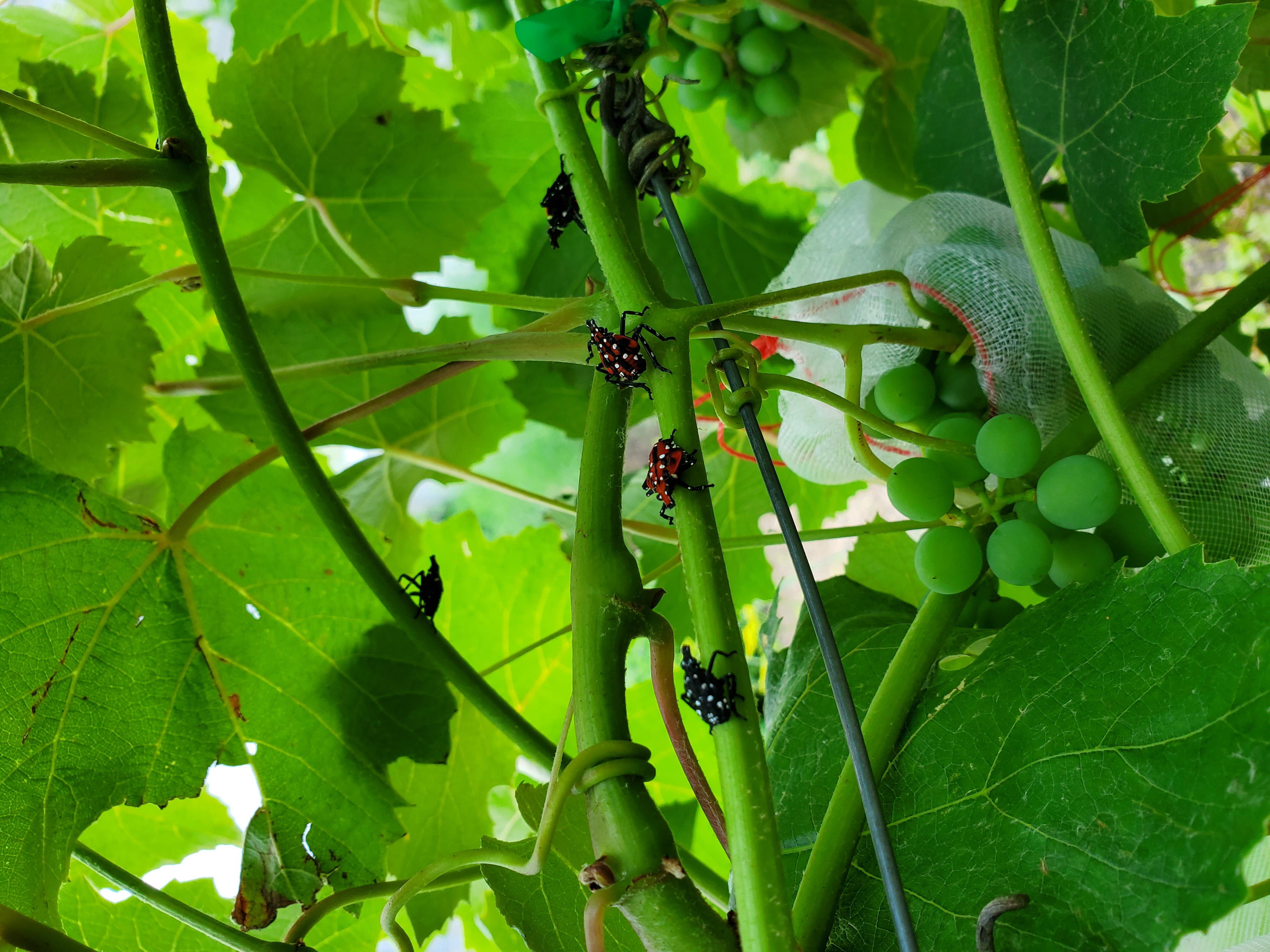Blog

Greener Gardening: Lanternflies
Greener Gardening is a blog series designed to help you make your garden, lawn and landscape more beautiful and sustainable by sharing the expert knowledge of Phipps professionals and educators.
Interested in learning more about pest management with Spotted Lanternflies? Click the video below to learn more from our experts here at Phipps!
Nymph and adult spotted lanternflies are showing up in gardens and landscapes throughout Western Pennsylvania and they are probably not welcome visitors. Despite being a nuisance, it’s important to keep in mind that they are not harmful to humans and do not greatly impact most healthy, mature plants.
Native to Asia, the spotted lanternfly was first spotted in eastern Pennsylvania in 2014 and is now found throughout the state. It is considered invasive because it has no known natural predators, spreads rapidly and has the potential to harm the state’s agriculture industries.
Phipps Integrated Pest Management Specialist Braley Burke says it’s important to remember that spotted lanternflies do not bite or sting people or pets and they tend to damage, but not kill, most plants. They will, however, possibly kill saplings and grapevines if heavily infested. Adult spotted lanternflies are attracted to many plants, including wild and cultivated grapevines, Virginia creeper and tree-of-heaven, a rapidly growing tree that is also native to Asia.
The pest’s food preferences include more than 70 plants and change throughout its life cycle.
“Spotted lanternfly nymphs love rose bushes,” Burke explains. “As adults, they tend to move on to deciduous trees.”
Spotted lanternflies go through four growth stages. When they emerge from the egg masses in the spring, they are small and look like spotted ticks, Burke said. They turn red with white spots as they grow. Spotted lanternflies in the nymph stage can’t fly, but hop and move fast.

Adults are seen starting in July and they are active until they are killed by hard freezes in the fall.
As they feed on plant sap, spotted lanternflies at all stages excrete liquid waste called honeydew, which can attract ants, wasps and bees. Sooty mold also thrives in honeydew. Burke says the honeydew makes plants and other surfaces sticky.
Penn State Extension Green Industry Educator Sandy Feather said honeydew is likely to have the biggest impact on home gardeners.
“Honeydew is a horrible, smelly mess,” she said, “and it’s hard to clean up.”
Gardeners might be tempted to reach for chemicals in an attempt to manage the nuisance pests, but experts urge not to do so.
Pesticides should only be considered as a last resort since any pesticide can unintentionally harm other organisms. Burke says organic pesticides are not ideal for managing spotted lanternflies because they don’t stay in the environment after they dry, so they do not control spotted lanternflies that migrate to the area. Neem oil and insecticidale soaps can help, she says, but would require applications every few days throughout the growing season. They are also not as effective on adult spotted lanternflies. Synthetic pesticides are also not a good option because they are expensive, stay in the environment for a long time, can leach into waterways and may harm other organisms.
Penn State Extension advises gardeners to even steer clear of home remedies to control spotted lanternflies as some mixtures might harm children, pets and even the plants themselves.
“Plants and dish soap are not a good combination, as soaps can remove some of a plant’s protective coating,” Burke says.
There are ways for gardeners to try to manage the spotted lanternfly. Start by doing all that you can to promote plant health because stressed plants are more likely to be affected by the spotted lanternfly.
“Spotted lanternfly might be that last nail in the coffin for a stressed tree,” Feather says.
Use plants that are appropriate for your yard. Choose native and sustainable plants that are resistant to disease and insects. Use proper planting, mulching, pruning and watering strategies to keep your plants healthy. See the Phipps Sustainable Landscape Principles for more ways to keep your plants healthy.
Over the winter and spring, you can smash, scrape and remove spotted lanternfly egg masses. Spotted lanternflies can lay eggs on any smooth outdoor surface. The egg masses, which are grayish-brown and mud-like, can be seen from the fall months through as late as June. Burke warns that the egg masses can be hard to spot and blend into many surfaces. Gardeners can scrape the egg masses off trees and other surfaces and destroy them by placing them in a container of rubbing alcohol. Smashing them works, too, Burke says.
Gardeners can remove spotted lanternflies at any growth stage from plants, trees and surfaces. Hand-picking frequently or using a shop vac with soapy water in it to drown the spotted lanternflies may help reduce the number in your garden, Burke says, but both methods require persistence. She adds that spotted lanternflies are very mobile, so others will quickly migrate back into any space that you clear.
“You can kill 10,000 of them, and the next day 10,000 more will come in,” Feather said. “You can’t keep new ones from coming in.”
There are spotted lanternfly traps that can be placed on the bases of trees and grapevines, but these must be built and placed properly to avoid catching other wildlife, Burke says. Sticky traps are not recommended, as they pose a risk to non-target animals, like birds and insect pollinators.
Some experts recommend removing tree of heaven from landscapes as it attracts spotted lanternfly. “Removing it might keep it from acting as a beacon,” Burke says, but adds that doing so is difficult. Cutting down tree of heaven causes it to regenerate with aggressive roots and sprouts. Penn State Extension has tips for managing tree of heaven.
Everyone can help keep spotted lanternflies from spreading.
There are places outside Allegheny County that don’t have as many spotted lanternflies or don’t have any at all. Feather suggests checking anything that is stored outside before moving it. “Spotted lanternflies are very good hitchhikers,” says Feather. “Any outdoor surface is fair game.”
The Pennsylvania Department of Agriculture has a checklist for travelers to ensure that they don’t unwittingly transport the pests.
“Don’t let the spotted lanternflies travel with you,” Burke says. “Take a minute to check your supplies and vehicle to make sure you’re not carrying them somewhere else.”
Spotted lanternfly will likely continue to be a nuisance in the areas for the next few years, but researchers are currently finding and testing spotted lanternfly management strategies and tools that will keep them in check without damaging our ecosystem. Our native and established predators, like some birds, small mammals and predatory insects, may also help manage this edible pest.
For more help with your landcare needs, contact a Phipps-accredited Sustainable Landcare Professional.

